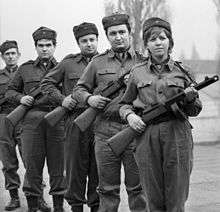Workers' Militia



The Workers' Militia (Hungarian: Munkásőrség) was a paramilitary organization in the Hungarian People's Republic from 1956 to 1989.
Following the quelled Hungarian Revolution of 1956, the Revolutionary Workers'-Peasants' Government ordered on February 18, 1957 the formation of the Workers' Militia. It replaced the revolutionary regime's special police force (karhatalom or also known as pufajkások, named after their Soviet-style quilted jackets). The slate-grey uniformed and armed Militia's aim was to defend the means of production. It was a voluntary service, but obviously offered some career advantages. Starting with 20,000 members, it gradually developed into a large armed force (60,000 strong in 1988[1]), although they were never deployed.
The first commander of the organization was Lajos Halász (1957–1962), followed by Árpád Papp (1962–1970), then lastly Sándor Borbély (1970–1989).
On October 31, 1989, a referendum was held with the question: "Should the Workers' Militia be disbanded?". The answer was an overwhelming Yes (94.9%), a result which confirmed the previously-adopted law (1989 XXXth).
See also
Similar formations:
References
- ↑ "Hungary - Workers' Guard". www.country-data.com. Retrieved 2018-01-09.